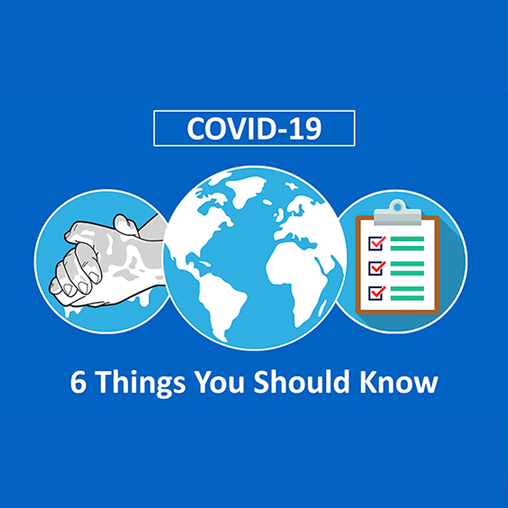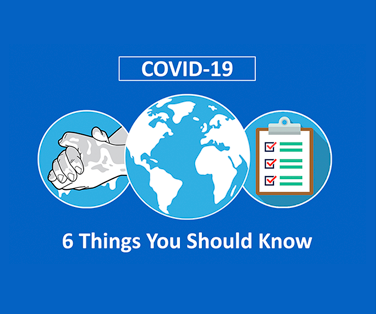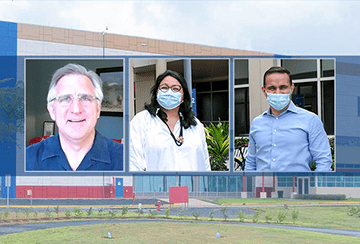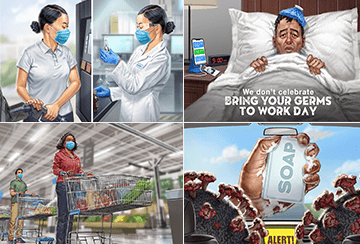The global coronavirus pandemic, of which the first cases were detected and reported in late 2019, is the result of a novel coronavirus, named SARS-CoV-2 by the World Health Organization (WHO), that causes the disease COVID-19. This challenging and fast-moving health crisis is having significant impacts on families, communities, health systems and millions of people around the world.
Leading public health officials agree that the best way to slow the spread of this novel coronavirus is for people around the world to understand the signs and symptoms of the disease, while collectively following proven disease prevention measures, like the ones mentioned below, to help protect members of our communities who are most at risk.
1. What are the symptoms of COVID-19?
General symptoms of COVID-19 according to the WHO:- Fever, tiredness, and dry cough are the most common symptoms
- 1 in 6 people with COVID-19 becomes seriously ill and develops difficulty breathing
- 80% of people recover from COVID-19 without needing special treatment
Emergency warning signs of COVID-19 according to the Centers for Disease Control and Prevention (CDC):
Anyone experiencing any of the following emergency warning signs for COVID-19 should seek medical attention immediately. Emergency warning signs include*:- Difficulty breathing or shortness of breath
- Persistent pain or pressure in the chest
- New confusion or inability to arouse
- Bluish lips or face
*This list is not all inclusive. Please consult your medical provider for any other symptoms that are severe or concerning.
2. How does coronavirus spread, and who is at risk?
From the CDC webpage on How COVID-19 Spreads.
- Between people who are in close contact with one another (within about 6 feet).
- Through respiratory droplets produced when an infected person coughs or sneezes.
Contact with contaminated surfaces or objects may also spread the coronavirus. According to the CDC, “it may be possible that a person can get COVID-19 by touching a surface or object that has the virus on it and then touching their own mouth, nose, or possibly their eyes.”
Anyone can get COVID-19 if exposed to SARS-CoV-2, and anyone can potentially be at risk of serious illness. However, the CDC states on the webpage People at Risk for Serious Illness from COVID-19 that the highest risk groups are elderly adults and people who have other serious health concerns, including those with heart disease, diabetes and lung disease.
3. Are there any treatments for COVID-19?
According to the CDC: “There is no specific antiviral treatment recommended for COVID-19. People with COVID-19 should receive supportive care to help relieve symptoms. People who think they may have been exposed to COVID-19 should contact their healthcare provider immediately.”
According to the WHO: “While some western, traditional or home remedies may provide comfort and alleviate symptoms of COVID-19, there is no evidence that current medicine can prevent or cure the disease. WHO does not recommend self-medication with any medicines, including antibiotics, as a prevention or cure for COVID-19.”
4. What to do if you feel sick
From the CDC’s What to Do if You Are Sick resource: “There is no specific antiviral treatment recommended for COVID-19. People with COVID-19 should receive supportive care to help relieve symptoms.”
The CDC recommends that people experiencing emergency warning signs seek medical care immediately while following the CDC’s recommendations to help prevent the spread of COVID-19 while sick.
For people who suspect they may have COVID-19, but aren’t sick enough to be hospitalized, the CDC recommends Caring For Yourself at Home following the comprehensive list of recommendations provided, which includes limiting contact with other people to avoiding spreading the disease further.
5. How to protect yourself and reduce the risk of getting COVID-19
The CDC’s Steps to Prevent Illness page offers comprehensive information for how people can protect themselves and those around them. These recommendations include information about regular handwashing, cleaning and disinfecting everyday items, social distancing, and who should wear facemasks (primarily caregivers and people who are infected who will be in close contact with others).
6. What is social distancing?
The Center for Infectious Disease Research and Policy (CIDRAP) defines social distancing as: “Measures taken to restrict when and where people can gather to stop or slow the spread of infectious diseases. Social distancing measures include limiting large groups of people coming together, closing buildings and canceling events.”
Around the world, many governments, schools and business have implemented social distancing protocols by asking people to study or work from home whenever possible; canceling festivals, meetings, conferences and other gatherings; and encouraging people to limit close contact with others when possible.
Check the following websites for the latest updates:





